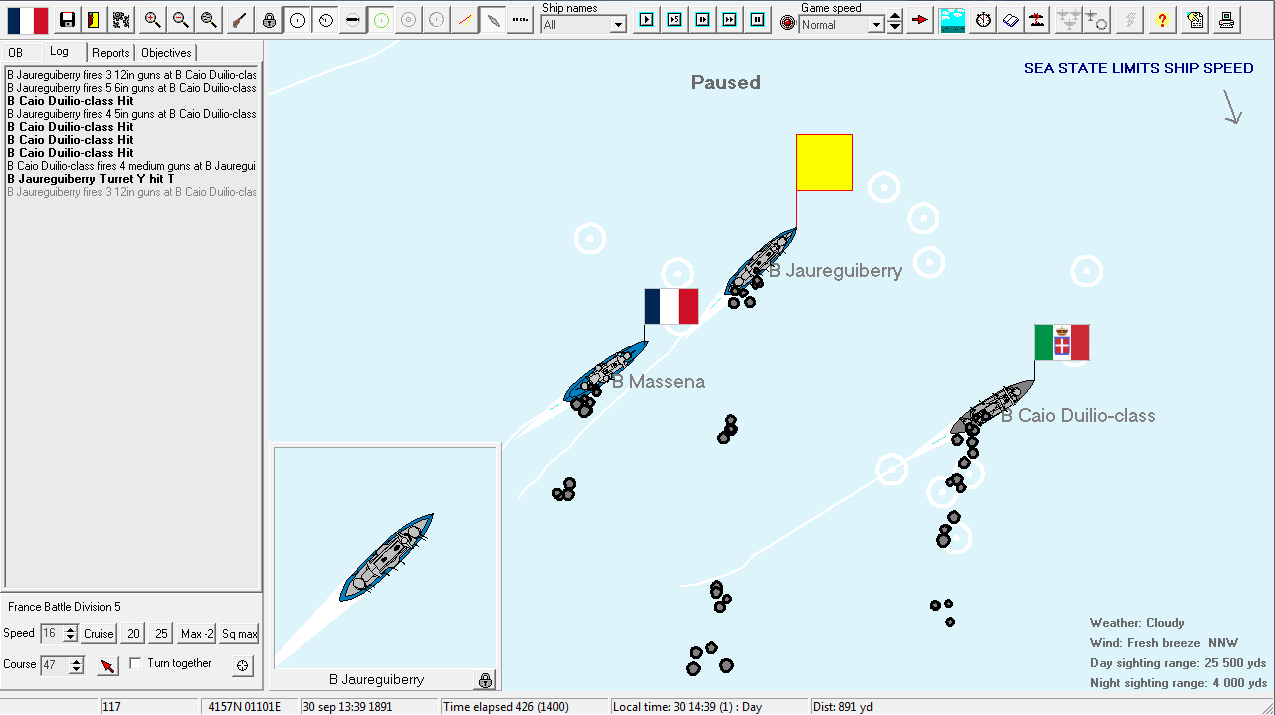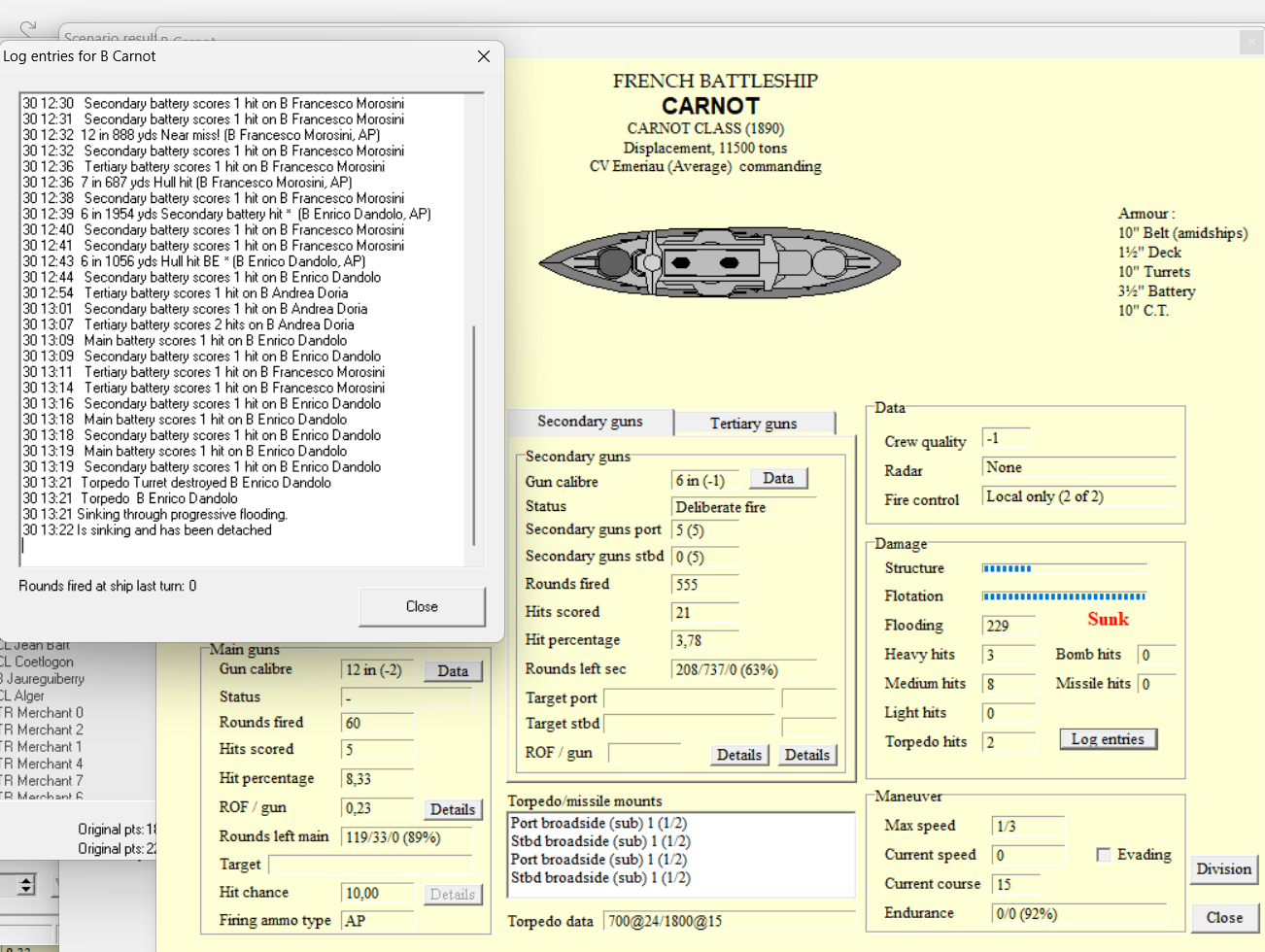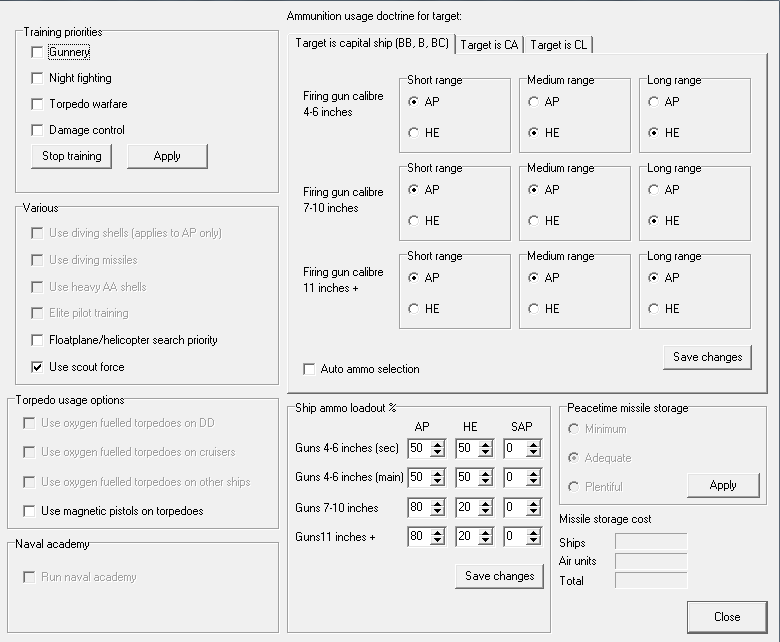Dasein wrote: Wed May 10, 2023 11:39 am
Regarding armour, don’t take my word for it but watching some of the AARs, it looks to me that in RTW3 armour quality in 1890 is just a bit inferior to that in 1900.
Looking at the guns penetration figures in RTW3, it seems in 1890 battleships only need 8in belts or so to stop anything at any range (i.e. armour in 1890 is better in the game than it was historically). It may have been a conscious choice to make the game easier, because if we give battleships 18" belts in 1890, as it was historically the case, it may be a bit confusing when after 1900 we start using the far stronger Krupp armour and end up with thinner but better protection! And 8" and 9" belts is what we already use in 1900, so it's easy to understand if we start using that already in our designs in 1890.
Anyway, to give us in RTW3 the 1890 feel with some of those beautiful ships with narrow very thick belts and low freeboard, AI is the only one designing everybody’s legacy fleet, and it gives us some really nice 1890 ship designs. Of course the set up is not perfect:
1. Giving ships very thick belts but of a better armour quality that it was historically the case, makes them in RTW3 impregnable to our main guns at any range. (I guess they still may be disabled or even sunk with some luck and a lot of effort involving our secondary guns, a lucky hit and torpedoes)
2. If 9in belts are perfectly OK, that means we can start building battleships in 1890 like the ones we would build in 1900: with normal and extended armour, normal freeboard, medium range and normal accommodation if we want to. That's what youtubers are doing, and it gives us a big advantage if all other navies keep on building old designs for a while.
In fairness, going more historically accurate on armour may have complicated the game experience, and not everybody is interested in armour (they would need to make clear to the player than the 16" of armour our gun can penetrate are normal steel, or Compound or whatever but not Krupp and that can be confusing for some) and it would also add further difficulty for the more mainstream casual player they want to reach now. We may have enjoyed it as we know what Compound or Harvey or Krupp armour mean, but for the uninitiated new player, RTW3 may already be complicated enough. Still, I can’t but think that from my own point of view it’s a lost opportunity: it would have been fun if we had been forced to use 16in belts to protect us against enemy guns and on limited displacement. In any case, it’s understandable if they’ve decided to keep it simple and make the 1890 start different on what it could be different (like new "old fashion" AI ships designs or the use of KEs in battle) and keep it similar to the 1900 start in others (like armour strength and ship design by us)
I've always regarded the Game's "Armour Thickness" to be a value in "Equivalent Inches of Krupp Cemented" as that is the standard (near universally) in use for anything being built in 1900. The various IG Techs that then drop to incrementally improve on Armour Quality do quite a good job at reflecting the real incremental improvement that carried on throughtout the whole era of armouring ships.
This means that simulating earlier armour types merely requires coming up with some method of finding an equivalent value in "Krupp Inches". Luckily the late 19th century was abristle with enthusiastic experimenters firing massive guns at test plates and surplus Ironclads so we really do have some fairly reliable "Figures of Merit" for comparing the types that emerge (from the early 1880s when Compound turns up to roughy 1896 when Krupp becomes the new-kid) with plain Iron, which was obviously their default.
It's possible to work back from Iron to Krupp fairly easily to allow the older types to be scaled down appropriately:
For example
6" of early Krupp Steel (our "Game Inches") is roughly equal to...
c.10 Inches of Harvey Steel (as used in most of the 1st generation of Majestic style pre-Dreadnoughts designed the first half of the the 1890s, it's face hardened Nickel Steel)
c.12.8 Inches of Compound Armour (a laminate of Steel and Iron plates and the widely used in the the 1880s...)
Between 11.3 and 12.8 Inches of Steel Armour (this competed with Compound throughout the 1880s eventually, with improving alloys, winning as "Nickel Steel" becomes available in c.1889)
c.16 Inches of plain Iron. (By the way, the thick wood backing fitted behind most Ironclads armour is worth about 1 inch of Iron per Foot of Teak etc...for this game that's barely noticeable but if you're writing for the earlier era you need to factor it in)
This means that we can build (In Game)
HMS Alexandra (Central Battery Ironclad, late 1870s - at least half the protected warships afloat in 1890 should be this style of beastie)
12 inch Iron Belt = c.4.5 inches of our Krupp Steel Equivalent
Guns: 12 x 10+11 in Muzzle Loading Rifles (Q-3) : these would penetrate about 12 inches of Iron at 1000 yards, equal to about 4.5 inches of KS
HMS Inflexible (Masted Turret Ship, in service early 1880s)
24 inch Iron Citadel = c.9.5 inches of KS
Guns: 4 x 16 in Muzzle Loading Rifles (Q -3 if anything is!) : these would penetrate about 22.5 inches of Iron at 1000 yards, equal to about 9 inches of KS
HMS Royal Sovereign (proper Pre-dreadnoughts, in service early 1890s)
18 inch Compound Belt = c.9 inches of KS
Guns: 4 x 13.5 in BL (Q -2) : These would penetrate 28 inches of Iron at 1000 yards, equal to about 12 inches of our KS
HMS Majestic (Pre-dreadnoughts, in service late 1890s)
9 inch Harvey Steel Belt = c.6 inches of KS
Guns: 4 x 13.5 in BL (Q -2) : These would penetrate 28 inches of Iron at 1000 yards, equal to about 12 inches of our KS
As you see, none of these ships are utterly out of sorts with penetrating their own Armour at the expected battle ranges and reflect the endless Guns vs Armour race quite nicely... to incorporate them into the 1890 game you only need an explanation of the equivalence method and sonething to make sure the older armours are appropriately cumbersome? (when I built my own retro fleets for RTW2 - QV - I fudged the ships displacements etc as compensation as needed)
I understand that this sort of detail maybe beyond the interest and casual understanding of many players new to the ERA but since the designers CHOSE to expand into the 1890s it is a little disappointing that they are just using the early area as a vague preface to the later stuff?
Part of the joy of RTW is the challenge between building the best now vs building better in 2 or 3 years time, the race against evolving technologies lends a constant freshness to the choices you must make as "First Sea Lord" or whatever. If the new decade becomes ten years of relative stability (which it absolutely wasn't!) then that would be a shame IMHO. Hopefully patches and especially the lively modding community will be able to fill some of the gaps over time?
 French and Italian Ironclads in combat
French and Italian Ironclads in combat An after battle look at the French Battleship Carnot. One torpedo is bad news for a predreadnought battleship, and two means a guranteed rapid sinking. As you can see from the ranges in the log, combat in this era tends to be at short ranges.
An after battle look at the French Battleship Carnot. One torpedo is bad news for a predreadnought battleship, and two means a guranteed rapid sinking. As you can see from the ranges in the log, combat in this era tends to be at short ranges. The doctrine screen with options for ammunition type used against different targets depending on range
The doctrine screen with options for ammunition type used against different targets depending on range

